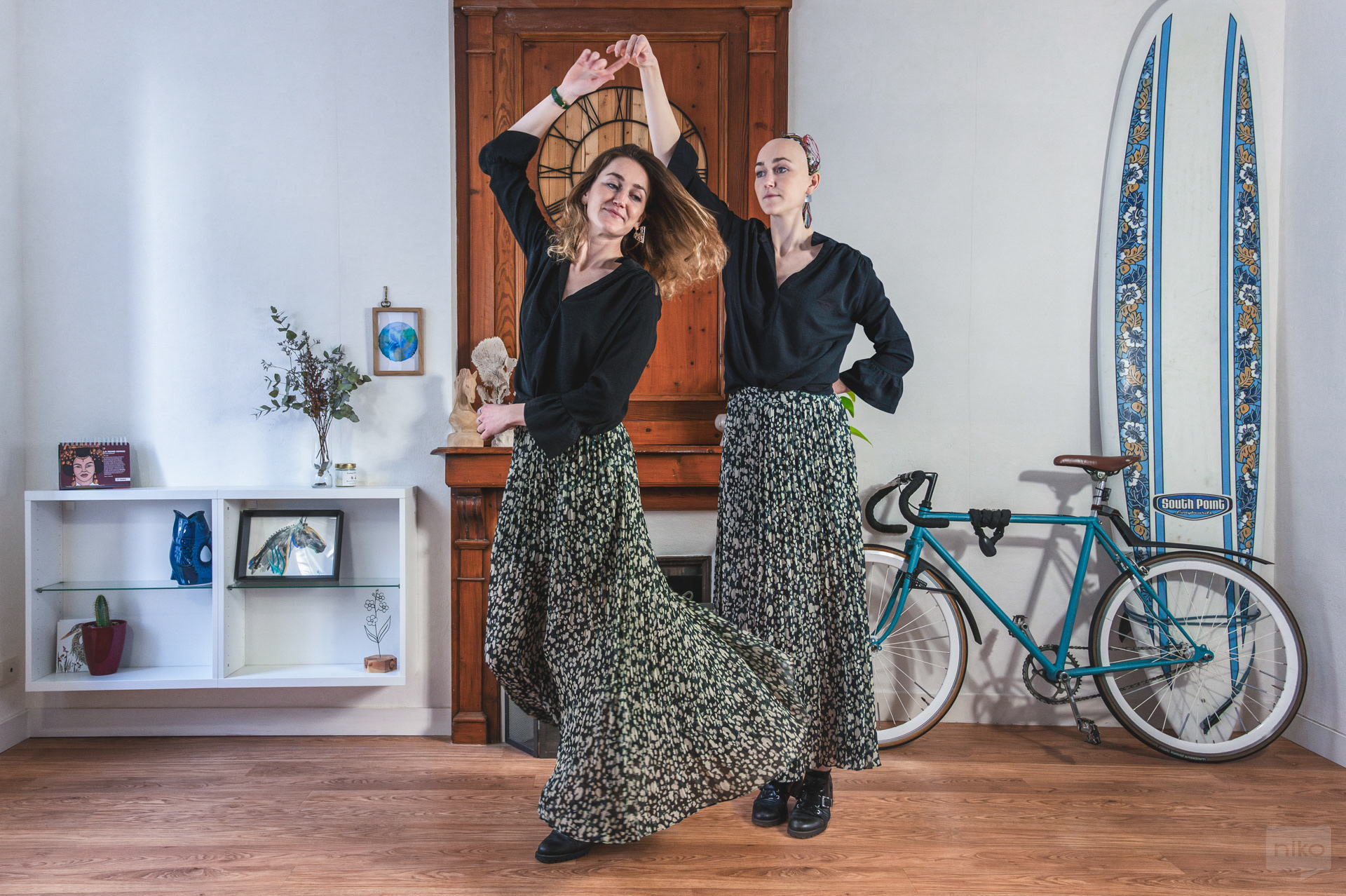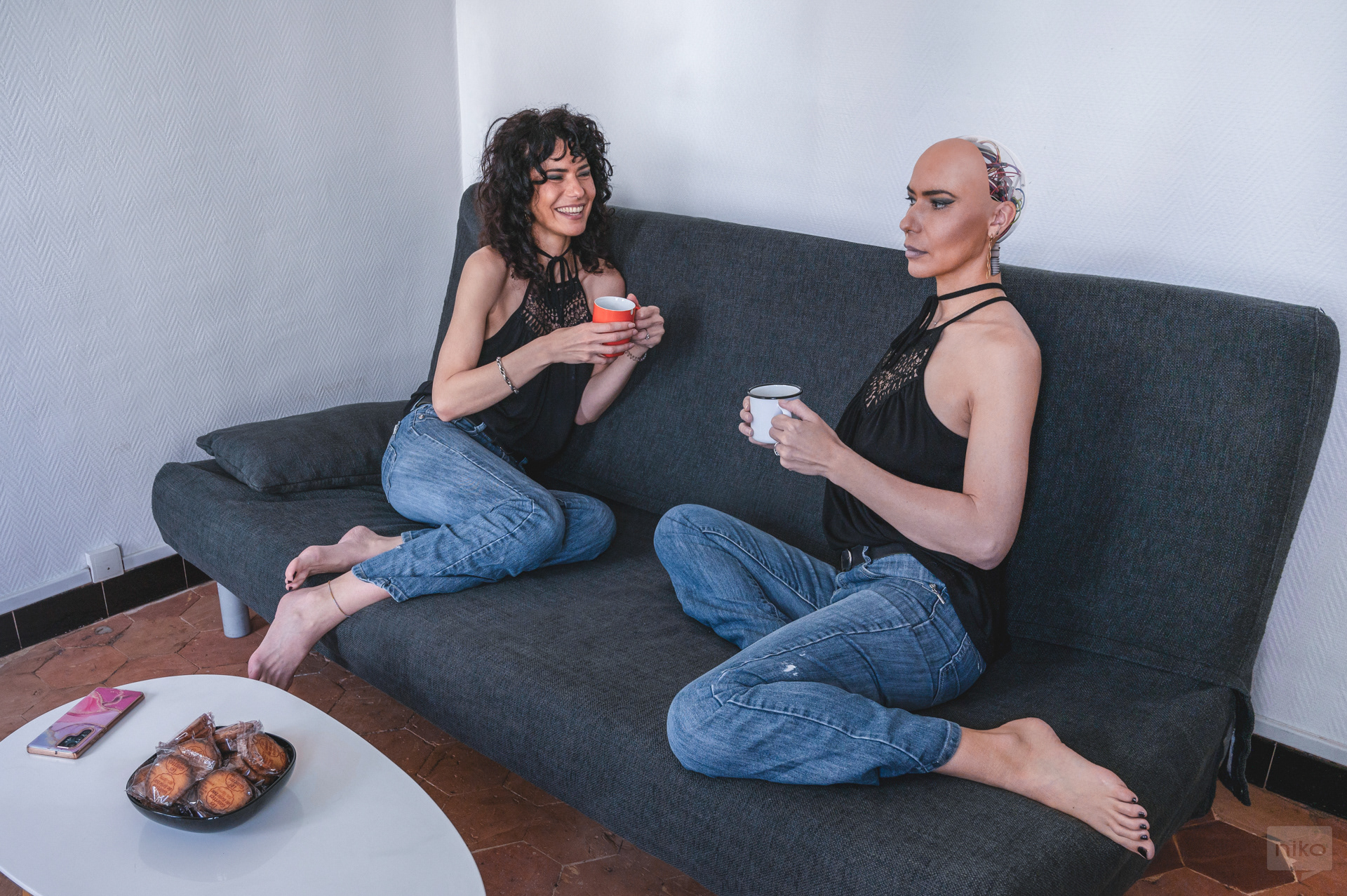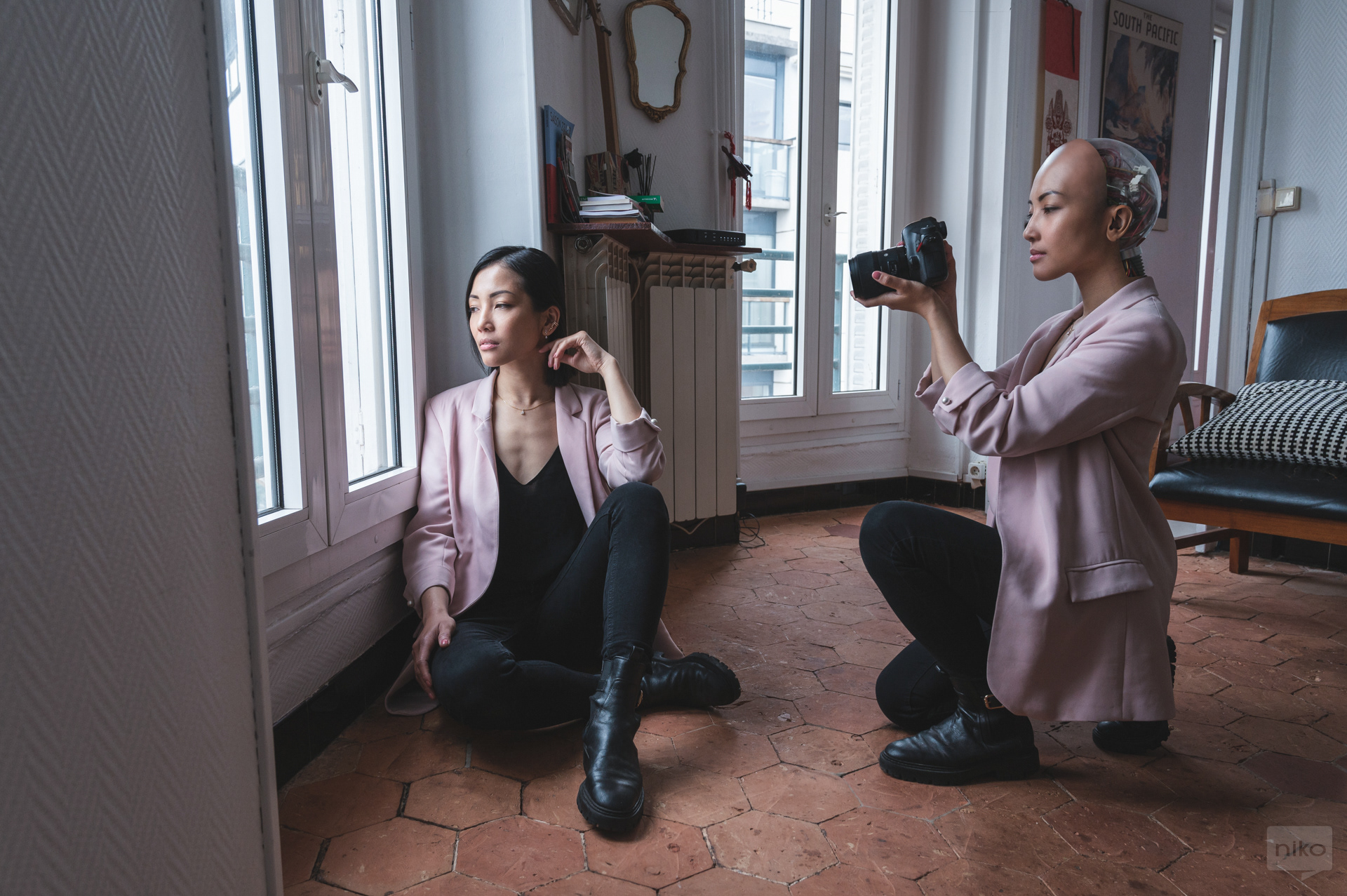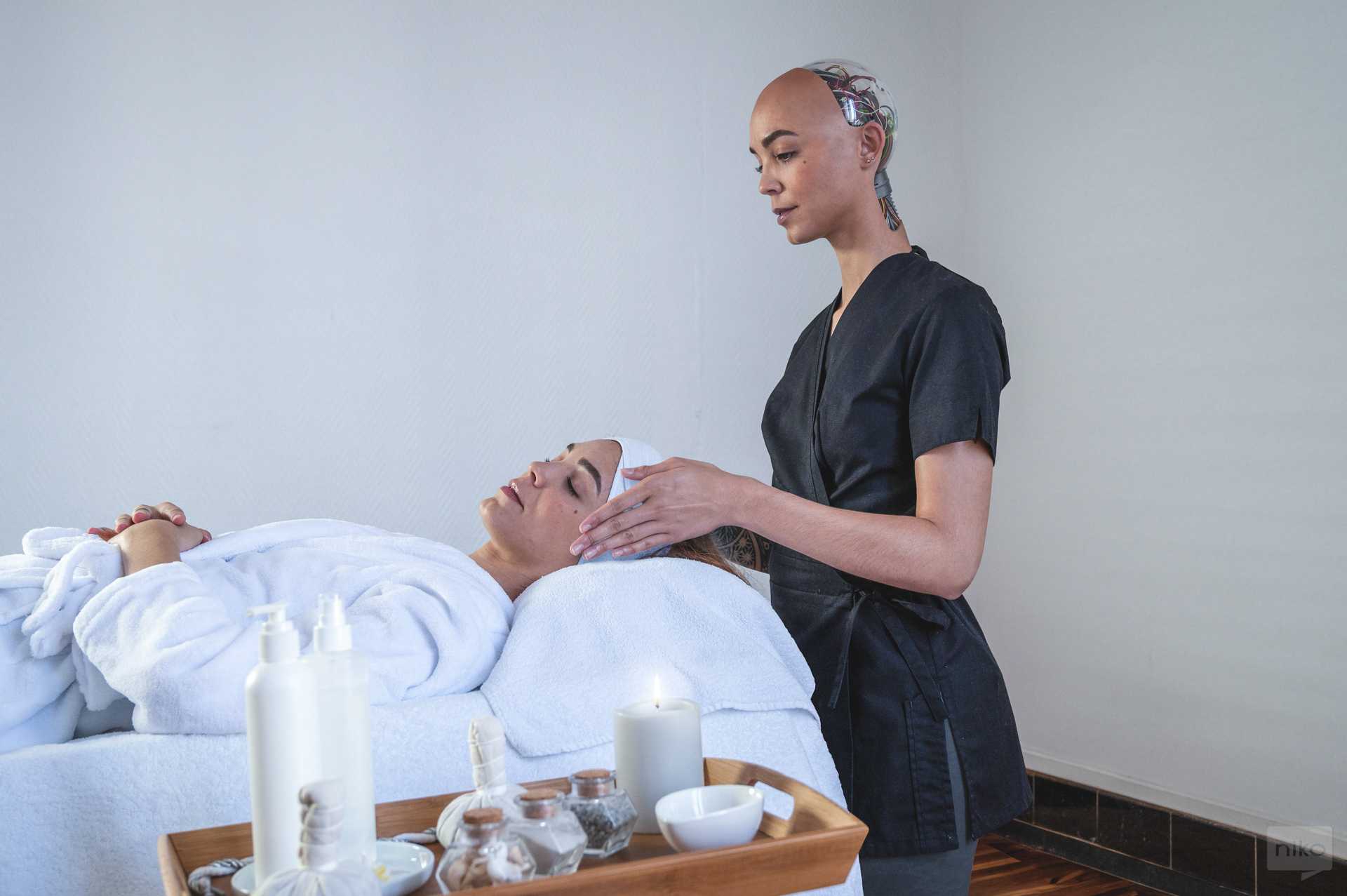Artistic project.
This project is still part of my research on the existence of robots and Artificial Intelligences in a fictional daily life... or almost.
In the universe of The Robot Next Door project, this small series illustrates, always with a touch of humour, the massive arrival of AI in our professional and personal lives.
These digital intelligences invest, among other things, in the fields of creation and the arts. But coupled with robotics, these new beings could very well assist us in all imaginable fields. More or less relevant and useful.
How far are we willing to let all this technology into our lives? What impact can this have on our ways of learning, creating, thinking? And what are the consequences for our human relationships?
In the universe of The Robot Next Door project, this small series illustrates, always with a touch of humour, the massive arrival of AI in our professional and personal lives.
These digital intelligences invest, among other things, in the fields of creation and the arts. But coupled with robotics, these new beings could very well assist us in all imaginable fields. More or less relevant and useful.
How far are we willing to let all this technology into our lives? What impact can this have on our ways of learning, creating, thinking? And what are the consequences for our human relationships?

Creativity Assisted by AI

Ballroom Dancing Assisted by AI

Beach Game Assisted by Ai

Beauty Assisted by AI

Boxing Assisted by AI

Calligraphy Assisted by AI

Chit Chatting Assisted by AI

Cleaning Assisted by AI

Contrast Assisted by AI

Dancing Assisted by AI

Defending Assisted by AI

Discovering Assisted by AI

Dressing Assisted by AI

Fitness Assisted by AI

Friendship Assisted by AI

Makeup Assisted by AI

Memories Assisted by AI

CV Photo Assisted by AI

Painting Assisted by AI

Photography Assisted by AI

Support Assisted by AI

Pilate Assisted by AI

Playful Assisted by AI

Reading Assisted by AI

Replacement Assisted by AI

Running Assisted by AI

Self Taping Assisted by AI

Skating Assisted by AI

Substitution Assisted by AI

Therapy Assisted by AI

Well Being Assisted by AI

Almost Assisted by AI

Over Assisted by AI

Trip Assisted by AI
Behind The Scene
I organized for the second time a photo session in Paris in May 24.
The main goal was to work with new people outside of my usual network in a different context... than usual.
It doesn’t seem like much, but it does represent a bit of organization!
This time, I thought of documenting behind the scenes in the form of short video sequences recounting the different stages of the process.
This will amuse me when I get old.
(Videos dedicated to social networks on mobile)
I organized for the second time a photo session in Paris in May 24.
The main goal was to work with new people outside of my usual network in a different context... than usual.
It doesn’t seem like much, but it does represent a bit of organization!
This time, I thought of documenting behind the scenes in the form of short video sequences recounting the different stages of the process.
This will amuse me when I get old.
(Videos dedicated to social networks on mobile)
First step: searching for models.
It's a long and difficult step because there are plenty of photo models, but I'm not just looking for photo models. I like working with people who have specialties or particular skills. Dancers, actors, athletes of all kinds, I rely on the particularities of people to imagine situations.
In addition, it has become more difficult to get in touch with people: messaging filtering on social networks, distrust of dubious photographers or fake profiles.
So you have to be patient and persevering.
Once the models have been identified, comes the second phase: trying to make contact!
You have to find the right email addresses, write clear briefings, not too long (people won't read them to the end) but too short either to give enough information and attract attention... or not.
Then wait for answers... and here too, you have to be very very patient and relaxed with cross fingers. On average it takes 1 response for 15 requests, knowing that this response can be negative!
So you have to start step 1 again.
When you receive a positive response, it's party time!
Second step: Search for ideas and concepts.
Once contact is established with the models, I begin to communicate in writing (or by telephone in rare cases) to learn more about the personalities of the models, their passions, their activities or their desires. This allows me to target staging ideas that correspond to the people. This is what makes my projects so rich: the diversity of the people who participate!
Ideas come from thoughts that come from all sorts of inspirations. I take the time for this step. I then propose the ideas to the models and we discuss them with the aim of mutually validating the concepts to be depicted.
When everything is validate, it's party time! Again!
Step 3: preparation.
I never use 3D, stock images and even less AI-generated images to produce my mechanical elements visible in my images. These are real accessories, home made with salvaged parts or objects constructed for the occasion.
So you have to build, select and transport everything for the photo shoots. In this case, I had 530 km of driving to do so the train was not possible.
Step 4: photo shootings.
This is of course the coolest part because it's the opportunity to meet people from all walks of life and work together on a project for a few hours. It is very enriching!
I have a fairly well-established working method and I explain as much as possible to the models because everything is clear in my head but not necessarily for others.
In this format, sessions last 2 or 3 hours, tea included.
Step 5: back home.
After 4 days of photo sessions, you have to go home and unload the equipment and photos. We then have to sort each series of images to send them to the models who help me choose the images to use for the montages. Here too, it is a collaborative way and must be done in the days following the shots.
This operation takes time but is necessary because I want to start with my photo montage with the right images without having to go back.
Step 6: post-production.
This is the longest and most detailed part. You have to arrange all the elements one by one for each photo montage. An image can take between 2 and 5 hours on average. But as I try to do as much as I can during the session, I save time in front of the computer. In addition, with AI tools in Photoshop, it has become easier to erase an annoying detail in the background or rough out certain tasks in retouching. I don't generate new objects, it's mostly deletion.
Step 7: the result.
And there you have it, all that for that! When I have finished the images, I show them to the models so they can validate or not. But since they participated in the selection of the input images, the risk of disappointing is limited.
Once everyone agrees, we can share and distribute the work.
Enjoy!
Some key figures:
- 1956 photos
- 4 days and 3 nights
- 6 people (model, actresses and dancer)
- 1066 km round trip, 10h30 round trip
- Apartment on the 4th floor without elevator x 14 rises = 56 floors
- Around fifteen hours of shooting
A big thank you to the models who actively participated in the project:
Lanael, model
Laura, fitness coach
Albane, artist and intern in psychiatry
Juliette, actress
Annaelle, actress
Cassandre, model and graphic designer
Marine, artist and video editor
Gabrielle, calligrapher & art director
Emeline V, photographer & model
Emeline P, actress & model
Phany, actress & model
Mado, dancer
It's a long and difficult step because there are plenty of photo models, but I'm not just looking for photo models. I like working with people who have specialties or particular skills. Dancers, actors, athletes of all kinds, I rely on the particularities of people to imagine situations.
In addition, it has become more difficult to get in touch with people: messaging filtering on social networks, distrust of dubious photographers or fake profiles.
So you have to be patient and persevering.
Once the models have been identified, comes the second phase: trying to make contact!
You have to find the right email addresses, write clear briefings, not too long (people won't read them to the end) but too short either to give enough information and attract attention... or not.
Then wait for answers... and here too, you have to be very very patient and relaxed with cross fingers. On average it takes 1 response for 15 requests, knowing that this response can be negative!
So you have to start step 1 again.
When you receive a positive response, it's party time!
Second step: Search for ideas and concepts.
Once contact is established with the models, I begin to communicate in writing (or by telephone in rare cases) to learn more about the personalities of the models, their passions, their activities or their desires. This allows me to target staging ideas that correspond to the people. This is what makes my projects so rich: the diversity of the people who participate!
Ideas come from thoughts that come from all sorts of inspirations. I take the time for this step. I then propose the ideas to the models and we discuss them with the aim of mutually validating the concepts to be depicted.
When everything is validate, it's party time! Again!
Step 3: preparation.
I never use 3D, stock images and even less AI-generated images to produce my mechanical elements visible in my images. These are real accessories, home made with salvaged parts or objects constructed for the occasion.
So you have to build, select and transport everything for the photo shoots. In this case, I had 530 km of driving to do so the train was not possible.
Step 4: photo shootings.
This is of course the coolest part because it's the opportunity to meet people from all walks of life and work together on a project for a few hours. It is very enriching!
I have a fairly well-established working method and I explain as much as possible to the models because everything is clear in my head but not necessarily for others.
In this format, sessions last 2 or 3 hours, tea included.
Step 5: back home.
After 4 days of photo sessions, you have to go home and unload the equipment and photos. We then have to sort each series of images to send them to the models who help me choose the images to use for the montages. Here too, it is a collaborative way and must be done in the days following the shots.
This operation takes time but is necessary because I want to start with my photo montage with the right images without having to go back.
Step 6: post-production.
This is the longest and most detailed part. You have to arrange all the elements one by one for each photo montage. An image can take between 2 and 5 hours on average. But as I try to do as much as I can during the session, I save time in front of the computer. In addition, with AI tools in Photoshop, it has become easier to erase an annoying detail in the background or rough out certain tasks in retouching. I don't generate new objects, it's mostly deletion.
Step 7: the result.
And there you have it, all that for that! When I have finished the images, I show them to the models so they can validate or not. But since they participated in the selection of the input images, the risk of disappointing is limited.
Once everyone agrees, we can share and distribute the work.
Enjoy!
Some key figures:
- 1956 photos
- 4 days and 3 nights
- 6 people (model, actresses and dancer)
- 1066 km round trip, 10h30 round trip
- Apartment on the 4th floor without elevator x 14 rises = 56 floors
- Around fifteen hours of shooting
A big thank you to the models who actively participated in the project:
Lanael, model
Laura, fitness coach
Albane, artist and intern in psychiatry
Juliette, actress
Annaelle, actress
Cassandre, model and graphic designer
Marine, artist and video editor
Gabrielle, calligrapher & art director
Emeline V, photographer & model
Emeline P, actress & model
Phany, actress & model
Mado, dancer